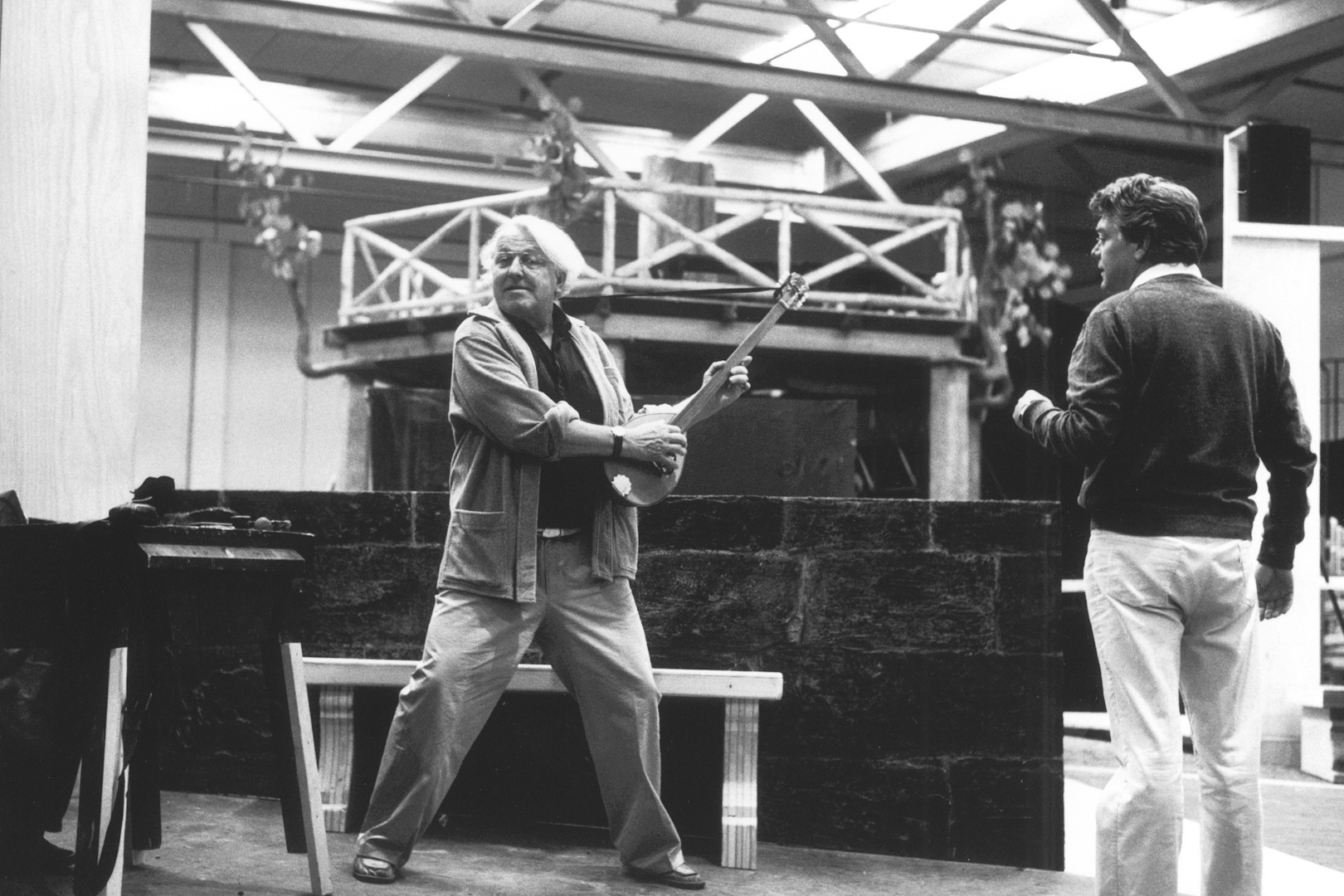Richard Wagner Museum Bayreuth

The long-standing Bayreuth festival director Wolfgang Wagner in focus
TEXT: JESSICA HOLZHAUSEN | PHOTO © WILHELM RAUH
For almost 60 years, Richard Wagner’s grandson Wolfgang Wagner directed the Bayreuth Festival. As artistic director, stage designer and director, he significantly shaped the reception of Wagner’s work. Therefore, celebrating his 100th birthday, the Richard Wagner Museum Bayreuth dedicates to him an anniversary exhibition in 2019.
“Among opera lovers, Wolfgang Wagner was always overshadowed by his brother Wieland, but for actors in Bayreuth, he was an old-school theatre father figure,” says curator Oliver Zeidler. In fact, Wolfgang Wagner had a decisive influence on the Bayreuth Festival: he opened it up to foreign directors and gave it a solid basis by establishing the Richard Wagner Foundation in 1973.
Today, Bayreuth is a unique testimony of German opera history. In addition to the festival hall, there is a Baroque opera house and the Richard Wagner Museum. Here, visitors often want to experience the atmosphere in Richard Wagner’s home ‘Wahnfried’. The museum, with its three buildings, is a journey through history and also covers the dark parts of Wagner’s legacy: as early as 1923, Adolf Hitler was a welcome visitor in the Siegfried Wagner house, therefore, this part of the exhibition focuses on the family’s involvement with the Nazi regime.
Richard Wagner: Der Ring des Nibelungen – Die Walküre, third act, third scene. Bayreuth festival 1976 – 1980. Musical direction: Pierre Boulez. Production: Patrice Chéreau. Stage design: Richard Peduzzi. Costumes: Jacques Schmidt. Photo: Siegfried Lauterwasser (1980), (C) Bayreuther Festspiele GmbH.
This made a new beginning after 1945 difficult. “From 1951, Wolfgang’s brother Wieland achieved the feat that Wagner could be staged again,” says Oliver Zeidler. He succeeded by depoliticising the opera. “With Wolfgang Wagner, the social reference to the present was then restored.”
Wolfgang was the sole director of the festival from 1966, but the decisive turning point came in 1976 with Patrice Chéreau’s Jahrhundertring. As social allegory of the 19th century, he put the “Ring” in the context of the criticism of capitalism and the analysis of political power structures. “When it premiered, the production was demonised,” says Zeidler. Opera lovers handed out whistles and there were brawls at the driveway. “It calmed down in the second year, and in the third, the production already had cult status.” Today, the Jahrhundertring still influences how Wagner is shown on stage. It is therefore an important topic in the exhibition. Conversations with contemporary witnesses will also play a large part – in the exhibition and the supporting programme.

Richard Wagner: Der Ring des Nibelungen – Das Rheingold, first scene. Bayreuth festival 1976 – 1980. Musical direction: Pierre Boulez. Production: Patrice Chéreau. Stage design: Richard Peduzzi. Costumes: Jacques Schmidt. Photo: Jean-Marie Bottequin (1978), (C) Bayreuther Festspiele GmbH.
Der langjährige Bayreuther Festspielleiter Wolfgang Wagner im Fokus
Nahezu 60 Jahre hat Richard Wagners Enkel, Wolfgang Wagner, die Bayreuther Festspiele geleitet. Als Intendant, Bühnenbildner und Regisseur hat er maßgeblich die Rezeption der Werke Wagners mitgeprägt. Zu seinem 100. Geburtstag widmet das Richard Wagner Museum Bayreuth ihm daher 2019 eine Jubiläumsausstellung.
„Wolfgang Wagner stand bei Opernliebhabern oft im Schatten seines Bruders Wieland, für die Darsteller in Bayreuth war er aber ein Theatervater alten Typs“, sagt Kurator Oliver Zeidler. Tatsächlich hat Wolfgang Wagner die Bayreuther Festspiele entscheidend geprägt: Er öffnete die Festspiele für auswärtige Regisseure und stellte sie mit der Gründung der Richard-Wagner-Stiftung 1973 auch strukturell solide auf.
Heute ist Bayreuth ein einmaliges Zeugnis deutscher Operngeschichte. Neben dem Festspielhaus stehen hier ein barockes Opernhaus und das Richard Wagner Museum. Hier wollen die Besucher vor allem die Atmosphäre in Richard Wagners Wohnhaus ‚Wahnfried‘ spüren. Das Museum mit seinen drei Gebäuden ist eine Reise durch die deutsche Geschichte und lässt dabei auch Wagners dunkles Erbe nicht außen vor: Im Siegfried Wagner-Haus war bereits ab 1923 Adolf Hitler gern gesehener Gast, deshalb widmet sich dieser Teil der Ausstellung auch den Verstrickungen der Familie in den Nationalsozialismus.
Umso schwieriger war der Neuanfang für die Festspiele nach 1945. „Wolfgangs Bruder Wieland hat ab 1951 erreicht, dass man Wagner überhaupt wieder aufführen konnte“, sagt Oliver Zeidler. Das gelang, indem er die Opern entpolitisierte. „Mit Wolfgang Wagner wurde dieser gesellschaftliche Bezug zur Gegenwart dann wieder hergestellt.“
Wolfgang leitete ab 1966 die Festspiele alleine, die entscheidende Wende aber kam 1976 mit dem ‚Jahrhundertring‘ des Regisseurs Patrice Chéreau. Als gesellschaftliche Allegorie des 19. Jahrhunderts stellt er den Ring in einen Kontext von Kapitalismuskritik und Analyse politischer Machtstrukturen. „Bei der Premiere wurde die Inszenierung verteufelt“, sagt Zeidler. Opernfreunde verteilten Trillerpfeifen, an der Auffahrt gab es Schlägereien. „Im zweiten Jahr hatte es sich etwas beruhigt, im dritten war die Inszenierung bereits Kult.“ Der ‚Jahrhundertring‘ beeinflusst bis heute, wie Wagner auf der Bühne gezeigt wird. Entsprechend großen Raum nimmt das Thema in der Sonderausstellung ein. Dabei werden Gespräche mit Zeitzeugen eine große Rolle spielen – in der Ausstellung wie auch im geplanten Rahmenprogramm.
Proteste gegen die Ringinszenierung von Patrice Chéreau 1976. (C) Richard Wagner Museum mit Nationalarchiv
Subscribe to Our Newsletter
Receive our monthly newsletter by email







